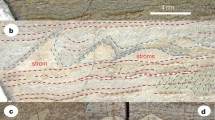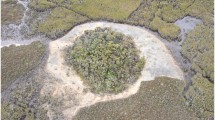Abstract
The approximately 3400-million-year history of the Archaean and Proterozoic Eons is rich in the fossil remains of organosedimentary structures called stromatolites, built primarily by cyanobacteria. Stromatolites first appear 3500 Ma ago and argue well for the presence and therefore great antiquity of cyanobacteria. The presence of cyanobacteria in such ancient rocks indicates that the evolution of the major prokaryotic phyla had occurred by Early Archaean time.
Although rare in the Archaean and first 300 million years of the Proterozoic, stromatolites undergo diversification and increase in abundance in the late Early Proterozoic due, in large part, to the oxygenation of the atmosphere-hydrosphere system, permitting cyanobacteria to disperse, colonize, and thrive in shallow continental shelf-like environments produced during earlier and contemporaneous periods ofcratonization. A second diversification occurred in the Early to Middle Riphean (approximately 1500 to 1200 Ma ago), and might in some way be due to the appearance of eukaryotes. A sharp drop in stromatolite diversity occurs during the Vendian (675 to 570 Ma ago) and is probably due to the activity of metazoans. Two diversity plateaus occur, one separates the two diversifications and the other occurs after the last diversification and before the Vendian decline.
Stromatolites are the products of the complex interactions of microbial, sedimentary, and environmental factors. While stromatolites are not well understood from a biogeological per-spective, they do provide valuable evidence for ancient life, they are useful for biostratigraphy and palaeoecology, and their distributional and diversity patterns provide insight into the first 3 billion years of the history of life on this planet.
Access this chapter
Tax calculation will be finalised at checkout
Purchases are for personal use only
Preview
Unable to display preview. Download preview PDF.
Similar content being viewed by others
References
Awramik SM (1971) Precambrian columnar stromatolite diversity: reflection of metazoan appearance. Science 174: 825–827
Awramik SM (1986) New fossil finds in old rocks. Nature (London) 319: 446–447
Awramik SM, Riding R (1988) Role of algal eukaryotes in subtidal columnar stromatolite formation. Proc Natl Acad Sci USA 85: 1327–1329
Awramik SM, Schopf JW, Walter MR (1983) Filamentous fossil bacteria from the Archean of Western Australia. Precambrian Res 20: 357–374
Awramik SM, Schopf JW, Walter MR (1988) Carbonaceous filaments from North Pole, Western Australia: are they fossil bacteria in Archean stromatolites? A discussion. Precambrian Res 39: 303–309
Bambach RK (1985) Classes and adaptive variety: the ecology of diversification in marine faunas through the Phanerozoic. In: Valentine JW (ed) Phanerozoic diversity patterns. Univ Press, Princeton, pp 191–253
Barghoorn ES, Tyler SA (1965) Microorganisms from the Gunflint chert. Science 147:563–577 Bertrand-Sarfati J, Walter MR (1981) Stromatolite biostratigraphy. Precambrian Res 15: 353–371
Black M (1933) The algal sediments of Andros Island, Bahamas. Philos Trans R Soc London Biol 222: 165–192
Buick R, Dunlop JSR, Groves DI (1981) Stromatolite recognition in ancient rocks: an appraisal of irregularly laminated structures in an Early Archaean chert-barite unit from North Pole, Western Australia. Alcheringa 5: 161–181
Burne RV, Moore LS (1987) Microbialites: organosedimentary deposits of benthic microbial communities. Palaios 2: 241–254
Byerly GR, Lowe DR, Walsh MM (1986) Stromatolites from the 3,300–3,500-Myr Swaziland Supergroup, Barberton Mountain Land, South Africa. Nature (London) 319: 489–491
Cameron EM, Baumann A (1972) Carbonate sedimentation during the Archean. Chem Geol 10: 17–30
Cao Rui-ji (1988) Study on stromatolite decline event in terminal Precambrian. Acta Palaeontol Sin 27: 737–750 (in Chinese with English summary)
Cloud P (1976a) Beginnings of biospheric evolution and their biogeochemical consequences. Paleobiology 2: 351–387
Cloud P (19766) Major features of crustal evolution. Geol Soc S Afr Annexure 79:1–33
Cloud P (1983) Banded iron-formations — a gradualist’s dilemma. In: Trendall AF, Morris RC (eds) Iron-formation: facts and problems. Elsevier, Amsterdam, pp 401–416
Golubic S (1973) The relationship between blue-green algae and carbonate deposits. In: Carr NG
Whitton BA (eds) The biology of blue-green algae. Blackwell, Oxford, pp 434–472
Golubic S (1976) Organisms that build stromatolites. In: Walter MR (ed) Stromatolites. Elsevier,Amsterdam, pp 113–126
Goodwin AM (1981) Precambrian perspectives. Science 213: 55–61
Hall J (1883) Cryptozoön n.g.; Cryptozoön proliferum n.sp. NY State Museum Ann Rep 36, Plate 6 Hoffman PF (1973) Recent and ancient algal stromatolites: seventy years of pedagogic cross-pol-
lination. In: Ginsburg RG (ed) Evolving concepts in sedimentology. Johns Hopkins Univ Press,Baltimore, pp 178–191
Hofmann HJ (1985) Precambrian carbonaceous megafossils. In: Toomey DF, Nitecki MH (eds) Paleoalgology: contemporary research and applications. Springer, Berlin Heidelberg New York Tokyo, pp 20–33
Kalkowsky E (1908) Oolith and Stromatolith im norddeutschen Buntsandstein. Dtsch Geol Ges 60: 68–125
Knoll AH (1985) The distribution and evolution of microbial life in the Late Proterozoic Era. Annu Rev Microbiol 39: 391–417
Krumbein WE (1983) Stromatolites — the challenge of a term in space and time. Precambrian Res 20: 493–531
Krylov IN (1963) Stolbchaty vetvyashchiesya stromatolity rifeiskikh otlozhenii yuzhnogo urala. Tr Geól Inst Akad Nauk SSSR 69: 1–133
Logan BW (1961) Cryptozoon and associated stromatolites from the Recent of Shark Bay, Western Australia. J Geol 69:517–533
Lowe DR (1980a) Archean Sedimentation. Annu Rev Earth Planet Sci 8:140–194
Lowe DR (1980b) Stromatolites 3,400-Myr old from the Archean of Western Australia. Nature (London) 284:441–443
Lowe DR (1983) Restricted shallow-water sedimentation of Early Archean stromatolitic and evaporitic strata of the Strelley Pool Chert, Pilbara Block, Western Australia. Precambrian Res 19:239–283
Margulis L, Schwartz KV (1982) Five Kingdoms. Freeman, San Francisco, 338 pp
Monty CLV (1967) Distribution and structure of Recent stromatolitic algal mats, eastern Andros Island, Bahamas. Ann Soc Geol Belg 90:55–100
Monty CLV (1973) Precambrian background and Phanerozoic history of stromatolite communities, an overview. Ann Soc Geol Belg 96:585–624
Pratt BR (1982) Stromatolite decline — a reconsideration. Geology 10:512–515
SchopfJW (1968) Microflora of the Bitter Springs Formation, late Precambrian, central Australia. J Paleontol 42: 651–688
Schopf JW (1977) Biostratigraphic usefulness of stromatolitic Precambrian microbiotas. Precambrian Res 5: 143–173
Schopf JW, Packer BM (1987) Early Archean (3.3 to 3.5 Ga-old) fossil microorganisms from the Warrawoona Group, Western Australia. Science 237: 70–73
Semikhatov MA (1976) Experience of stromatolite studies in the USSR. In: Walter MR (ed) Stromatolites. Elsevier, Amsterdam, pp 337–357
Semikhatov MA, Gebelein CD, Cloud P, Awramik SM, Benmore WC (1979) Stromatolite morphogenesis — progress and problems. Can J Earth Sci 16: 992–1015
Sepkoski JJ Jr (1979) A kinetic model of Phanerozoic taxonomic diversity. Il. Early Phanerozoic families and multiple equilibria. Paleobiology 5: 222–251
Valentine JW, Walker TD (1986) Diversity trends within a model taxonomic hierarchy. Physica 22D: 31–42
Vidal G (1984) The oldest eukaryotic cells. Sci Am 250: 48–57
Walcott CD (1914) Cambrian geology and paleontology Ill: Precambrian Algonkian algal flora. Smithsonian Misc Coll 67: 77–156
Walsh MM, Lowe DM (1985) Filamentous microfossils from the 3,500-Myr-old Onverwacht
Group, Barberton Mountain Land, South Africa. Nature (London) 314: 530–532
Walter MR (1976) Introduction. In: Walter MR (ed) Stromatolites. Elsevier, Amsterdam, pp 1–3 Walter MR (1983) Archean stromatolites: Evidence of the Earth’s earliest benthos. In: SchopfJW
ed) Earth’s earliest biosphere. Univ Press, Princeton, pp 187–213
Walter MR, Heys GR (1985) Links between the rise of the Metazoa and the decline of stromatolites. Precambrian Res 29: 149–174
Walter MR, Buick R, Dunlop JSR (1980) Stromatolites 3,400–3,500 Myr old from the North Pole area, Western Australia. Nature (London) 284: 443–445
Winsborough BM, Golubic S (1987) The role of diatoms in stromatolite growth: two examples from modern freshwater settings. J Phycol 23: 195–201
Woese CR (1987) Bacterial evolution. Microbiol Rev 51: 221–271
Zhu Shixing, Xu Chaolei, Gao Jianping (1987) Early Proterozoic stromatolites from Wutai Mt. and its adjacent regions. Bull Tianjin Inst Geol Min Res 17: 1–221 (in Chinese with English summary)
Author information
Authors and Affiliations
Editor information
Editors and Affiliations
Rights and permissions
Copyright information
© 1991 Springer-Verlag Berlin Heidelberg
About this chapter
Cite this chapter
Awramik, S.M. (1991). Archaean and Proterozoic Stromatolites. In: Riding, R. (eds) Calcareous Algae and Stromatolites. Springer, Berlin, Heidelberg. https://doi.org/10.1007/978-3-642-52335-9_15
Download citation
DOI: https://doi.org/10.1007/978-3-642-52335-9_15
Publisher Name: Springer, Berlin, Heidelberg
Print ISBN: 978-3-642-52337-3
Online ISBN: 978-3-642-52335-9
eBook Packages: Springer Book Archive




